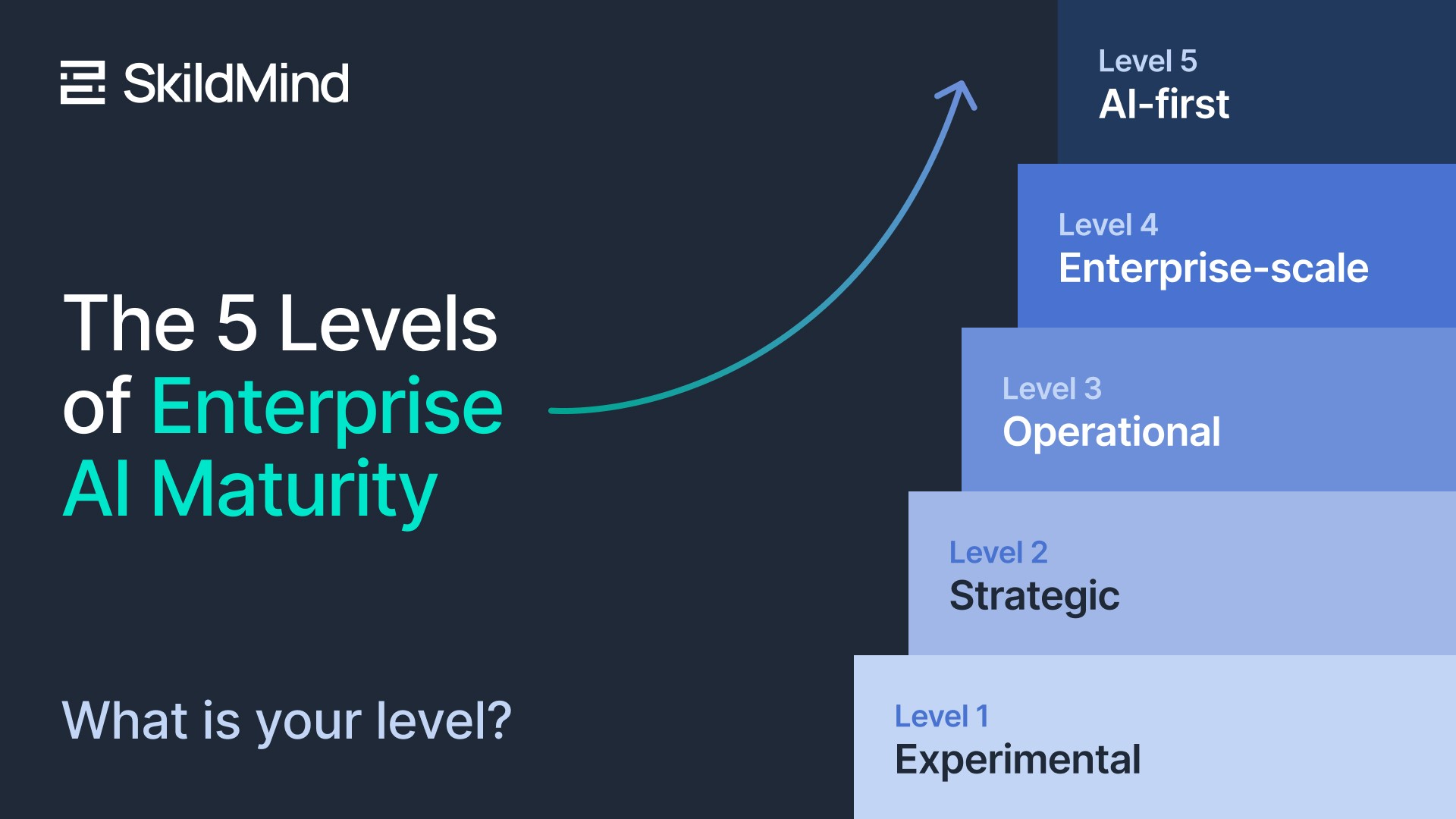
The 5 Levels of Enterprise AI Maturity

Founder and CEO
Generative artificial intelligence (GenAI) holds tremendous potential to create value for companies, and organizations that successfully harness its power to enhance their business operations are already outperforming industry peers. This is just the beginning. A McKinsey study indicates that, in the long term, the AI opportunity could generate $4.4 trillion in additional productivity growth from corporate use cases.
Yet, there's a persistent and massive gap between experimentation and value creation. While many organizations are running Gen AI PoCs, only 26% of companies have developed the necessary set of capabilities to move beyond and deliver real business value, according to a new study by Boston Consulting Group (BCG).
Challenges with Scaling AI initiatives in Enterprise
After years of investing and numerous pilot projects, business executives are now seeking tangible returns on their AI investments. However, realizing its full value remains difficult for various reasons.
First, aligning AI initiatives with strategic business objectives has proved challenging for most organisations. Too often, AI PoCs are spearheaded by individual champions within specific departments, which can create silos and disconnect them from other areas of the organization. In the absence of a strategic roadmap, which highlights clear objectives, prioritizes high-impact use cases, and flesh out investments in AI capabilities – including governance, data, technology, operations, people, and culture – many of these PoCs fail to deliver substantial impact.
Second, gen AI introduces unique governance challenges. It is now well established that LLMs are prone to hallucinations, may exacerbate human bias, and AI agents can create new security vulnerabilities. Business leaders understand these complexities and the AI community as a whole is working hard to develop and implement the essential standards, and frameworks needed to ensure responsible, secure, and compliant use of AI in enterprise. Still, navigating these challenges is not straightforward, and often significantly slows down the pace of AI adoption within organizations.
Further, the AI skill gap is widening. The rapid pace of innovation in the AI industry is making it increasingly challenging to hire talent equipped with the expertise needed for enterprise-scale AI deployment. Indeed, AI engineers, full-stack developers, product managers, or AI governance leaders with practical experience of large-scale gen AI implementations are still scarce, concentrated in a few AI hubs, and are commanding high salaries.
In response, many executives are turning to workforce upskilling as a pragmatic solution. However, this is not necessarily an easier road. For AI upskilling initiatives to be truly effective, they must incorporate hands-on experimentation, foster supportive learning environments, be tailored to specific roles, and provide meaningful feedback from expert practitioners.
Our Enterprise AI Maturity Model
These difficulties are likely to persist until business executives engage in a fundamental paradigm shift. In practice, this transformation involves evaluating where they stand today in their AI journeys, identifying areas for improvement, designing a strategic roadmap for greater AI adoption, and continuously iterating based on rigorous evaluations. To guide them through this process, SkildMind has developed a comprehensive AI maturity model comprised of five distinct levels:
-
Level 1 – Experimental:
AI is a topic of discussion within the organization but lacks a strategic roadmap and governance frameworks. Individual teams may initiate preliminary exploratory AI projects, but these efforts are limited by legacy tech infrastructure, poor data quality and insufficient engagement from senior leadership. Also, AI literacy remains low, partly because of employee cultural resistance to AI adoption.
-
Level 2 – Strategic:
Organisations at this stage have a more structured approach to AI. Executive leadership is actively driving AI discussions, ensuring alignment with overarching business objectives. A collaborative strategic roadmap has been developed, engaging relevant teams under direct executive oversight. This process has allowed the organization to identify and prioritize high-impact use cases that directly support business key performance indicators (KPIs).
Additionally, robust governance frameworks have been established, informed by comprehensive AI risk assessments, and aligned with applicable regulations and industry standards. Finally, roles and responsibilities have been clearly defined.
-
Level 3 – Operational (AI Center of Excellence):
Moving to this stage is a significant achievement in an organization's AI journey. It demonstrates that all key AI capabilities spanning strategy and governance, data and technology, and people and culture are in place. Senior leadership is actively engaged in sponsoring and advancing AI initiatives. AI solutions are reliably deployed into production and are creating measurable business value. This level is best achieved through the establishment of an AI Center of Excellence (AI CoE).
-
Level 4 – Enterprise-scale:
Following the successful implementation of their AI Center of Excellence, executives are now positioned to scale AI initiatives across their organisation. With a robust AI infrastructure, reusable workflows, and advanced AI observability capabilities in place, the organization can quickly expand to additional AI use cases. Moreover, they have managed to increase AI literacy to a point where employees clearly understand how AI can augment them in their specific roles. As a result, AI has become a fundamental component of the organization's culture, driving innovation and efficiency at every level.
-
Level 5 – AI-First:
Getting to this final stage is very challenging because it requires a fundamental organisational shift. At this point, all business workflows, products, and operations have been completely redesigned to make the most of AI innovations. In effect, AI solutions have become the primary engines of business value. From a talent perspective, this implies that employees have evolved beyond basic AI literacy to become true experts in using AI to increase their productivity.
The Way Forward
There is an increasing awareness among business leaders that their company's success in the age of AI hinges increasingly on their ability to quickly and continuously integrate AI innovations into their existing business workflows and products – or for the most forward-thinking companies to redesign them entirely. For most of them, this represents a daunting and unprecedented organizational challenge. SkildMind has designed this AI maturity model to offer them a structured approach to navigate this transformation.
Organizations can use this model to determine which stage of AI maturity they've reached already and design a strategic roadmap to reach the next stage. This task can be performed either by an internal team of AI leaders or with the support of SkildMind experts.
Regardless of where they are in your AI journey, we would also like to encourage business executives to persevere because, within the next decade, AI-driven companies are likely to be the most competitive. In this context, adopting a wait-and-see attitude would be a self-defeating strategy.
Ready to Assess Your AI Maturity Level?
Let SkildMind help you evaluate where your organization stands and design a strategic roadmap for AI success.
Book a Meeting